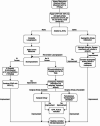Negative Pressure Pulmonary Edema Related to Laryngospasm and Upper Airway Obstruction in a Patient With Treacher Collins Syndrome
- PMID: 34079650
- PMCID: PMC8159308
- DOI: 10.7759/cureus.14426
Negative Pressure Pulmonary Edema Related to Laryngospasm and Upper Airway Obstruction in a Patient With Treacher Collins Syndrome
Abstract
Laryngospasm is an uncommon complication of anesthesia in adults but more common in pediatric anesthesia, which could present similarly to supraglottic upper airway obstruction. The management of such airway complications is even more difficult in patients with difficult mask ventilation and intubation. Our case illustrated the management of laryngospasm and negative pressure pulmonary edema in a patient with Treacher Collins syndrome. A literature search revealed few previous similar reports. We demonstrated an algorithm to differentiate between the true laryngospasm from the supraglottic upper airway obstruction, the management of laryngospasm in patients with difficult airways, and the recognition and management of negative pressure pulmonary edema as a complication of laryngospasm.
Keywords: difficult airway algorithm; laryngospasm; negative pressure pulmonary edema; treacher-collins syndrome; upper airway obstruction.
Copyright © 2021, Cheng et al.
Conflict of interest statement
The authors have declared that no competing interests exist.
Figures




Similar articles
-
[Negative pressure pulmonary edema: report of case series and review of the literature].Braz J Anesthesiol. 2019 Mar-Apr;69(2):222-226. doi: 10.1016/j.bjan.2018.11.005. Epub 2018 Dec 24. Braz J Anesthesiol. 2019. PMID: 30591273 Free PMC article. Review.
-
Anesthetic Management of Treacher Collins Syndrome in an Outpatient Surgical Center.Am J Case Rep. 2021 Sep 4;22:e931974. doi: 10.12659/AJCR.931974. Am J Case Rep. 2021. PMID: 34480792 Free PMC article.
-
[Pulmonary edema due to laryngospasm immediately after extubation].Masui. 2009 Sep;58(9):1172-4. Masui. 2009. PMID: 19764445 Japanese.
-
The prolonged use of the laryngeal mask airway in a neonate with airway obstruction and Treacher Collins syndrome.Paediatr Anaesth. 2003 Jul;13(6):530-3. doi: 10.1046/j.1460-9592.2003.01108.x. Paediatr Anaesth. 2003. PMID: 12846711
-
Postobstructive pulmonary edema following anesthesia.J Clin Anesth. 1990 Mar-Apr;2(2):116-20. doi: 10.1016/0952-8180(90)90064-a. J Clin Anesth. 1990. PMID: 2189449 Review.
Cited by
-
Negative pressure pulmonary edema (Review).Exp Ther Med. 2023 Aug 4;26(3):455. doi: 10.3892/etm.2023.12154. eCollection 2023 Sep. Exp Ther Med. 2023. PMID: 37614417 Free PMC article. Review.
References
-
- Perioperative laryngospasm - Review of literature. D’souza N, Garg R. https://www.researchgate.net/publication/344209193_Perioperative_Laryngo... Internet J Anesth. 2009;20:1–8.
-
- Pediatric laryngospasm. Hampson-Evans D, Morgan P, Farrar M. Paediatr Anaesth. 2008;18:303–307. - PubMed
-
- Incidence and Associated Factors of Laryngospasm among Pediatric Patients Who Underwent Surgery under General Anesthesia, in University of Gondar Compressive Specialized Hospital, Northwest Ethiopia, 2019: A Cross-Sectional Study. Birlie Chekol W, Yaregal Melesse D. Anesthesiol Res Pract. 2020;2020:3706106. - PMC - PubMed
-
- Post-extubation pulmonary edema following anesthesia induced by upper airway obstruction. Are certain patients at increased risk? Lorch DG, Sahn SA. Chest. 1986;90:802–805. - PubMed
-
- Supraglottic obstruction versus true laryngospasm: the best treatment. Rajan GR. Anesthesiology. 1999;91:581. - PubMed
Publication types
LinkOut - more resources
Full Text Sources
